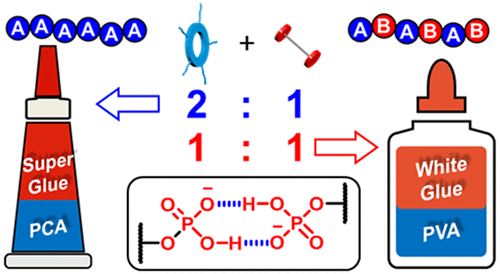当前位置:
X-MOL 学术
›
J. Am. Chem. Soc.
›
论文详情
Our official English website, www.x-mol.net, welcomes your
feedback! (Note: you will need to create a separate account there.)
Tunable Adhesion from Stoichiometry-controlled and Sequence-defined Supramolecular Polymers Emerges Hierarchically from Cyanostar-stabilized Anion-anion Linkages
Journal of the American Chemical Society ( IF 14.4 ) Pub Date : 2020-01-14 , DOI: 10.1021/jacs.9b12645 Wei Zhao 1 , Joshua Tropp 2 , Bo Qiao 1 , Maren Pink 1 , Jason D Azoulay 2 , Amar H Flood 1
Journal of the American Chemical Society ( IF 14.4 ) Pub Date : 2020-01-14 , DOI: 10.1021/jacs.9b12645 Wei Zhao 1 , Joshua Tropp 2 , Bo Qiao 1 , Maren Pink 1 , Jason D Azoulay 2 , Amar H Flood 1
Affiliation

|
Sequence-controlled supramolecular polymers offer new design paradigms for generating stimuli-responsive macromolecules with enhanced functionalities. The dynamic character of supramolecular links present challenges to sequence definition in extended supramolecular macromolecules, and design principles remain nascent. Here, we demonstrate the first example of using stoichiometry-control to specify the monomer sequence in a linear supramolecular polymer by synthesizing both a homopolymer and an alternating copolymer from the same glycol-substituted cyanostar macrocycle and phenylene-linked diphosphate monomers. A 2:1 stoichiometry between macrocycle and diphosphate produces a supramolecular homopolymer of general formula (A)n comprised of repeating units of cyanostar-stabilized phosphate-phosphate dimers. Using a 1:1 stoichiometry, an alternating (AB)n structure is produced with half the phosphate dimers now stabilized by the additional counter cations that emerge hierarchically after forming the stronger cyanostar-stabilized phosphate dimers. These new polymer materials and binding motifs are sufficient to bear normal and shear stress to promote significant and tunable adhesive properties. The homopolymer (A)n, consisting of cyanostar-stabilized anti-electrostatic linkages, shows adhesion strength comparable to commercial superglue formulations based on polycyanoacrylate but is thermally reversible. Unexpectedly, and despite including traditional ionic linkages, the alternating copolymer (AB)n shows weaker adhesion strength more similar to commercial white glue based on poly(vinyl acetate). Thus, the adhesion properties can be tuned over a wide range by simply controlling the stoichiometric ratio of monomers. This study offers new insight into supramolecular polymers composed of custom-designed anion and receptor monomers and demonstrates the utility of emerging functional materials based on anion-anion interactions.
中文翻译:

化学计量控制和序列定义的超分子聚合物的可调粘附从 Cyanostar 稳定的阴离子 - 阴离子键中分层出现
序列控制的超分子聚合物为生成具有增强功能的刺激响应大分子提供了新的设计范式。超分子链接的动态特性对扩展超分子大分子中的序列定义提出了挑战,设计原则仍然处于起步阶段。在这里,我们展示了第一个使用化学计量控制来指定线性超分子聚合物中单体序列的例子,方法是从相同的乙二醇取代的氰基星大环和亚苯基连接的二磷酸单体合成均聚物和交替共聚物。大环化合物和二磷酸盐之间的化学计量比为 2:1 产生通式 (A)n 的超分子均聚物,该均聚物由氰星稳定的磷酸盐-磷酸盐二聚体的重复单元组成。使用 1:1 的化学计量比,产生交替的 (AB)n 结构,其中一半的磷酸盐二聚体现在被额外的抗衡阳离子稳定,这些阳离子在形成更强的 cyanostar 稳定的磷酸盐二聚体后分层出现。这些新的聚合物材料和结合基序足以承受法向和剪切应力,以促进显着和可调的粘合性能。均聚物 (A)n 由 cyanostar 稳定的抗静电键组成,其粘合强度可与基于聚氰基丙烯酸酯的商业强力胶配方相媲美,但具有热可逆性。出乎意料的是,尽管包含传统的离子键,交替共聚物 (AB)n 显示出较弱的粘合强度,更类似于基于聚醋酸乙烯酯的商业白胶。因此,通过简单地控制单体的化学计量比,可以在很宽的范围内调整粘合性能。这项研究为由定制设计的阴离子和受体单体组成的超分子聚合物提供了新的见解,并展示了基于阴离子-阴离子相互作用的新兴功能材料的实用性。
更新日期:2020-01-14
中文翻译:

化学计量控制和序列定义的超分子聚合物的可调粘附从 Cyanostar 稳定的阴离子 - 阴离子键中分层出现
序列控制的超分子聚合物为生成具有增强功能的刺激响应大分子提供了新的设计范式。超分子链接的动态特性对扩展超分子大分子中的序列定义提出了挑战,设计原则仍然处于起步阶段。在这里,我们展示了第一个使用化学计量控制来指定线性超分子聚合物中单体序列的例子,方法是从相同的乙二醇取代的氰基星大环和亚苯基连接的二磷酸单体合成均聚物和交替共聚物。大环化合物和二磷酸盐之间的化学计量比为 2:1 产生通式 (A)n 的超分子均聚物,该均聚物由氰星稳定的磷酸盐-磷酸盐二聚体的重复单元组成。使用 1:1 的化学计量比,产生交替的 (AB)n 结构,其中一半的磷酸盐二聚体现在被额外的抗衡阳离子稳定,这些阳离子在形成更强的 cyanostar 稳定的磷酸盐二聚体后分层出现。这些新的聚合物材料和结合基序足以承受法向和剪切应力,以促进显着和可调的粘合性能。均聚物 (A)n 由 cyanostar 稳定的抗静电键组成,其粘合强度可与基于聚氰基丙烯酸酯的商业强力胶配方相媲美,但具有热可逆性。出乎意料的是,尽管包含传统的离子键,交替共聚物 (AB)n 显示出较弱的粘合强度,更类似于基于聚醋酸乙烯酯的商业白胶。因此,通过简单地控制单体的化学计量比,可以在很宽的范围内调整粘合性能。这项研究为由定制设计的阴离子和受体单体组成的超分子聚合物提供了新的见解,并展示了基于阴离子-阴离子相互作用的新兴功能材料的实用性。









































 京公网安备 11010802027423号
京公网安备 11010802027423号